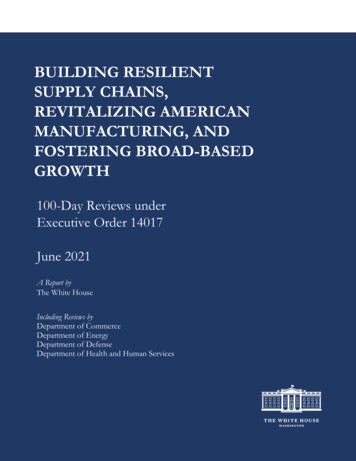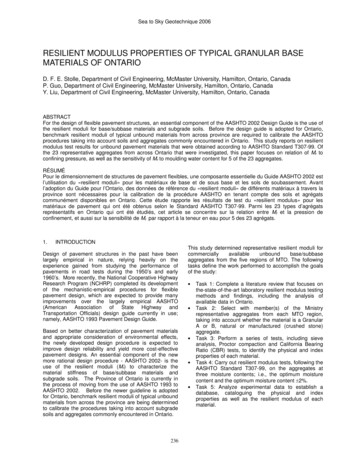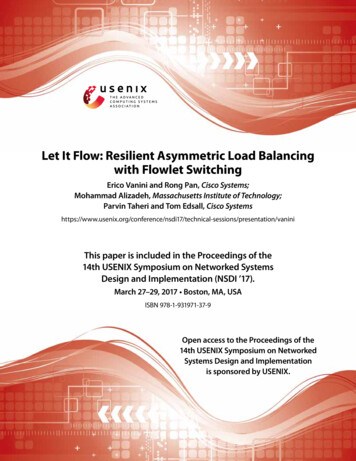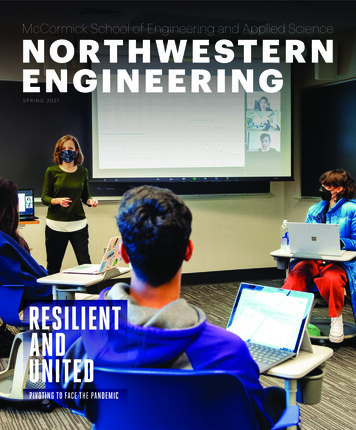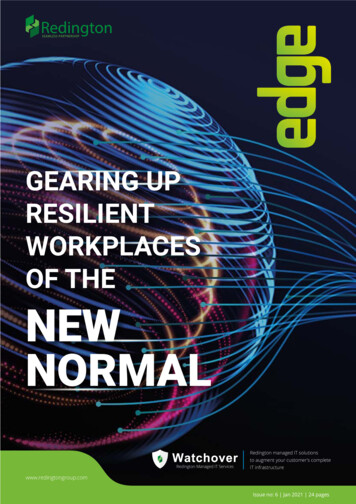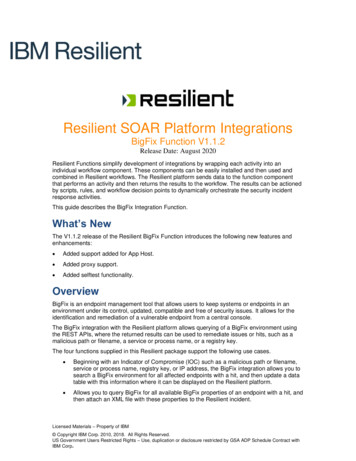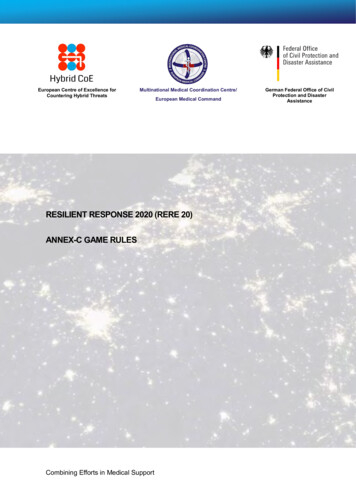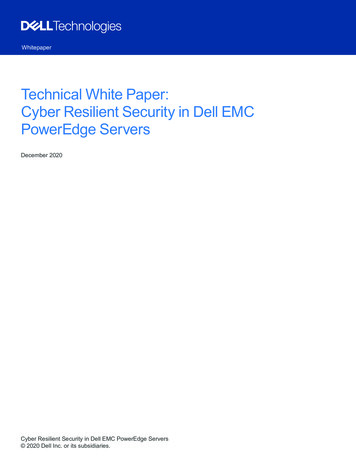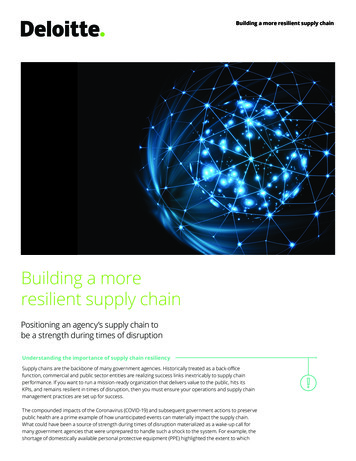
Transcription
Building a more resilient supply chainBuilding a moreresilient supply chainPositioning an agency’s supply chain tobe a strength during times of disruptionUnderstanding the importance of supply chain resiliencySupply chains are the backbone of many government agencies. Historically treated as a back-officefunction, commercial and public sector entities are realizing success links inextricably to supply chainperformance. If you want to run a mission-ready organization that delivers value to the public, hits itsKPIs, and remains resilient in times of disruption, then you must ensure your operations and supply chainmanagement practices are set up for success.The compounded impacts of the Coronavirus (COVID-19) and subsequent government actions to preservepublic health are a prime example of how unanticipated events can materially impact the supply chain.What could have been a source of strength during times of disruption materialized as a wake-up call formany government agencies that were unprepared to handle such a shock to the system. For example, theshortage of domestically available personal protective equipment (PPE) highlighted the extent to which
Building a more resilient supply chaingovernment agencies are reliant on foreign manufacturers andsuppliers for critical public health and national defense materials.Decades of lean supply chain management and decentralization havehollowed out the domestic supplier base and increased the risk andexposure for government supply chains. Simultaneously, governmentassets and programs have grown more complex. As agenciescontinue working to recover from COVID-19, they must prioritizetransforming their supply chain management practices to prepare forfuture disruptions, such as on-going economic uncertainty caused bycontinuing global health uncertainty, the impact to the supply chaindue to natural disasters or geopolitical instability, or the rising threatsof cyber-attacks to the digital aspects of the supply chain network.This type of transformation does not happen overnight – it requiresforward-thinking leadership with purpose and vision. Leaders willneed a keen eye and the proper tools to identify high risk areassuch as supply chain bottlenecks, foreign direct investments, criticalmaterial shortages, and counterfeit or obsolete parts. By acting now,government agencies can fortify their supply chains to enable themto thrive and better protect the public they serve.Supply chain risks common to government agenciesGovernment agencies have unique roles in the community, especially during times of crisis when theirsupply chain infrastructure becomes critical to the community. In many respects, government supplychains need to be more resilient than their commercial counterparts. Below are five common pitfalls thatgovernment agencies face in the wake of a supply chain disruptor event:Supplier Base: In today’s business environment, most supply chains have a global reach, including those of governmentagencies. The primary risk faced by most government agencies with respect to the supply base is a lack of visibility into thesupplier ecosystem beyond tier 1 suppliers. For government agencies, understanding the origin of critical components, aswell as the market strength of those companies supplying critical components should be a priority to prevent the cripplingeffects to the entire supply chain caused by disruptions to lower tier suppliers.IT Modernization and Security: Government agencies struggle with aging IT infrastructure and systems that arebecoming increasingly obsolete, costly to maintain, and vulnerable to cyber threats. Many of these aging systems havepoor interoperability with more contemporary IT solutions, thus hindering the adoption of modern and more cost-effectivesolutions throughout the supply chain.Coordination and Communication: Unlike most commercial organizations, where the supply chain exists to serve thatorganization, government agency supply chains can work to serve a wide variety of end users. Depending on the disruptorevent, government agency supply chain responses may require coordination between all levels of government – local, state,and federal – as well as, cross-agency and private and public coordination. Breakdowns in communication can lead to overpurchasing and underdelivering of supplies or bottlenecks in delivery.Inventory Management: Because of poor inventory management systems, government agencies often struggle tooptimize inventory control and effectively monitor when items need to be reordered and restocked. Without visibilityacross the supply chain, inventory replenishment can come in the form of extra, unnecessary purchases instead of thetransfer of existing inventory from a separate location to the point of need.Procurement: Inefficient procurement processes often plague government agencies. Long lead times from therequirements development process to contract award can exacerbate other supply chain issues. Additionally, the singlefocus on cost can cause the procurement function to be purely transactional. This approach misses out on the opportunityfor government agencies to leverage the procurement function as a driver of value to the larger organization, in terms ofimproved performance and the ability to capture innovation from the supply base, in addition to lowering the prices paidfor common services and products.
Building a more resilient supply chainCreating resiliencyResilient supply chains are flexible enough to resist breaking under strain yet have the capacity to return to anormalized state during recovery. Improving resiliency does not happen by chance or overnight. It requiresthoughtful leadership and a well-designed strategic plan that is tailored to meet the specific requirements ofyour organization. Leading organizations in both the commercial and government sector are taking steps toensure their teams are not only responding to the immediate needs resulting from a supply chain disruption, butalso preparing for inevitable future disruptions. Many are investing in technology-enabled solutions that providevisibility, flexibility, collaboration, and control.These following four pillars are essential to establish and maintain a secure supply chain in an uncertain future:VisibilityFlexibilityCollaborationControlA prerequisite for theother pillars, the abilityto illuminate supplierbase vulnerabilities andmonitor supply chainevents and patterns todrive proactive actionsThe ability to quicklyadapt to disruptionswithout significantlyincreasing operationalcosts or risks to missionsuccessThe ability to developinternal/externalsymbiotic and trustbased relationshipswith supply chainpartners and other keystrategic networksThe ability toimplement policies andexecute processes toprevent disruptionsThe four pillars explainedVisibility - Supplier Base Illumination:Supplier Base Illumination: One of the best ways government agenciescan build supply chain resiliency is by illuminating the supplier base.This insight enables agencies to diversify suppliers and improvestrategic sourcing and procurement. Understanding how services andproducts flow across the value chain allows an organization to validateand identify a cost-effective network needed to achieve the desiredservice level. Also, it spreads risk and mitigates the impact that social,political, and geographic incidents could have on material impact onprice and availability. Additionally, it can uncover domestic and foreignthreats, including counterfeit parts, hostile foreign direct investments,and high-risk, financially unstable private entities. Illuminatingthe supplier base supports decisive decision making needed toreestablish supplier relationships with domestic and internationalpartners to mitigate the effects of pandemics, economic recessions,and geopolitical conflictsVisibility in actionDeloitte worked with a national security agencyto perform supplier base due diligence onchemical components to a sanitizer product forfood processing. Using Deloitte’s CentralSight software to illuminate key component suppliersrevealed they were all obtaining the key chemicalcomponent from the same manufacturer inChina. With the resulting information, theagency was able to clearly assess their foreignsupplier risks, determine alternative sourcingopportunities, and outline cost savings.
Building a more resilient supply chainFlexibility and Collaboration - Digitizing and Automating the Supply Chain:Traditional supply chain models and functions are transitioning from manual processes and disparate systems to centralizedsupply chain networks backed by robust technology. Intelligent workflows and data-driven demand insights are relativelynew concepts that are rapidly becoming the new status quo. Rather than viewing supply chain functions as merelytransactional, leading organizations are using their digitized supply chains to increase organizational resiliency.COVID-19 has highlighted the need for government agencies to accelerate their adoption of mission-critical supply chaintechnology, automation, and digitization solutions. Forward-thinking organizations have taken this a step further byadopting technologies that support remote collaboration and coordination across supply chains. For example: Artificial intelligence and machine learning can increase supply and demand synchronization using sensor-drivenreplenishment Robotic process automation reduces reliance on manual labor and offsets the side effects of an afflicted workforce unableto conduct in-person tasks Internet of Things (IoT) enables communication among digital assets so that an organization’s workforce can focus onmaking holistic, data-driven decisions Blockchain can expedite acquisitions through “smart contracts” that can be used to replenish inventories at pre-definedthresholds using pre-negotiated terms, conditions, and pricing Advanced analytics can transform data from multiple disparate systems using algorithms, artificial intelligence, andmachine learning to provide invaluable management insights Digital/additive manufacturing can help offset the complications involved with raw material scarcity and transportationconstraints and disruptions during crisesAll of these enabling technologies can be managed from a supply chain control tower that integrates key managementfunctions into one central point of truth. These technologies (and many more) can help government agencies transitionto data-driven, digital supply chains. The result is an ability to monitor and adapt in real-time to changing circumstances,reducing the negative side effects from disruption.Control - Supply Chain Risk Management:A key step government agencies can take to help build in resiliency is a supply chain risk management review. When anorganization does not have enough visibility across the extended supply network, it risks overreliance on a single geographyor a single supplier for key products. The future of supply chain risk management calls for government agencies to do greaterdue diligence when procuring new resources and to identify potential vulnerabilities. Before new supplier relationships arecreated, agencies will need to assess how secure and viable their critical suppliers’ business is by determining whether theirsuppliers can withstand downturned economies or other business threats. To mitigate current vulnerabilities, organizationsshould work with key suppliers to understand the flexibility they have to shift production and purchase order fulfillment toother locations. Active communication and formulation of alternative plans are critical to minimizing potential impacts due tounexpected supplier limitations.Today, government agencies should implement a supply-chain risk management function in their portfolio aimed atidentifying, evaluating, and planning risk response strategies. Some federal government agencies, such as the U.S.Department of Defense and the Federal Emergency Management Agency, already use frameworks designed to predict andassess the impact of high-risk, low-probability (also known as “black swan”) events. Assessment determines whether thecurrent risk management approach fully meets the needs of the government agency and whether it is prepared to quicklyadjust and recover from any unanticipated supply chain disruptions that occur. Leading government agencies are realizingthat supply chain risk management is an enterprise-wide affair and are actively pulling in agency leaders to the process.
Building a more resilient supply chainWhere to startA logical and cost-effective starting point is a supply chain resiliency assessment. This exercise can helpgovernment agencies identify specific areas, such as process redesign, technology upgrades, or supplierdiversification, for further exploration and evaluation. The first step in conducting this assessment is todevelop an operations maturity model, either by using stakeholder inputs to conduct a gap analysis or usingsupply chain simulation software that highlights key areas for improvement and potential investment. Oncethese improvement areas have been identified, government agencies can assess the tradeoffs by usingcost-benefit analyses, impact assessments, and risk management frameworks. Some mission requirementsmay require teams to take assessment a step further in the form of war gaming or supply chain stress tests.The importance of acting nowThe decades-long concept of a lean, agile, and global supply chain is unsustainable when placed under extremeduress. Unfortunately, it appears the current pandemic will continue to have rippling effects in our communities.Continuous Disruption from COVID-19: Experts have predictedmultiple waves of COVID-19 outbreaks over the next 12-18 months (link).Economic Uncertainty: The pandemic’s economicchallenges continue to ripple around the world.Likely Future Disruptions: As supply chainscontinue to expand globally in an increasingly complex,interconnected n
The decades-long concept of a lean, agile, and global supply chain is unsustainable when placed under extreme duress. Unfortunately, it appears the current pandemic will continue to have rippling effects in our communities. Government must fortify their operations now
